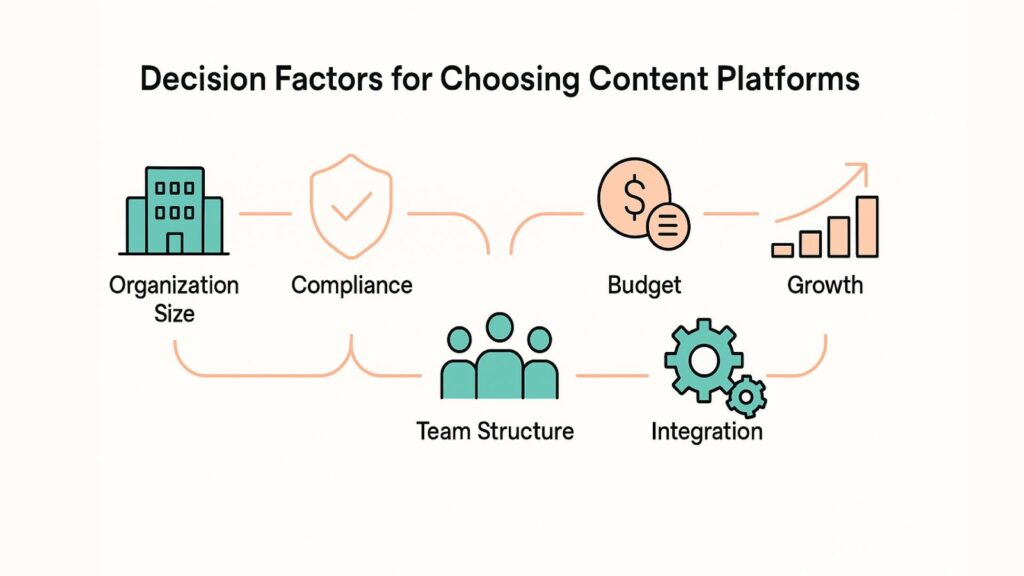Digital asset management and creative automation tools serve different but complementary roles in modern content operations.
- DAM software excels at organizing, storing, and governing existing brand assets across enterprise teams
- Creative automation tools specialize in scaling content production through AI-powered templates and batch creation
- Most successful brands use a hybrid approach that combines both capabilities for complete content lifecycle management
- The right choice depends on your organization’s size, compliance needs, and content volume requirements
Marketing teams are drowning in an endless cycle of producing more content faster while maintaining brand consistency across dozens of channels. This pressure has given rise to two distinct categories of solutions: digital asset management platforms that organize and govern existing content, and creative automation tools that streamline content production at scale.
The global DAM market is forecasted to exceed $8.1 billion by 2026, showcasing significant growth potential as organizations grapple with exponentially increasing content volumes. Meanwhile, creative automation tools have emerged as a response to the democratization of content creation driven by AI technologies.
But which content creation platform is right for your organization? The answer isn’t always straightforward and often involves understanding how these tools complement rather than compete with each other.
What’s the Fundamental Difference Between DAM and Creative Automation?
The core distinction between DAM software and creative automation tools lies in their primary purpose and where they fit in the content lifecycle.
Digital asset management platforms function as the central nervous system for your brand’s content ecosystem. They’re designed to store, organize, search, and distribute existing digital assets while maintaining strict governance and compliance controls. DAM is your brand’s content library and distribution center, where every asset has a home, proper metadata, and clear usage rights.
Creative automation tools focus on the production side of content operations. These platforms use templates, AI, and automated workflows to generate new content variations quickly and efficiently. They excel at taking a single creative concept and scaling it across multiple formats, channels, and audiences without manual recreation.
The distinction becomes clearer when you consider the problems each category solves. DAM software addresses the chaos of scattered assets, inconsistent branding, and compliance risks. Creative automation tools tackle the bottleneck of content production and the need for personalized, channel-specific variations.
Research on digital marketing challenges reveals that marketing teams face significant inefficiencies in content operations, with considerable time wasted searching for existing assets and struggles to produce enough content variations to support omnichannel strategies. This data illustrates why many organizations need both approaches.
Target Users and Technology Approaches
DAM platforms typically serve enterprise marketing teams, brand managers, and creative directors who need to maintain control over brand assets across large organizations. The technology focuses on metadata management, search capabilities, workflow automation, and integration with existing marketing technology stacks.
Creative automation tools target performance marketers, social media managers, and advertising teams who need to produce high volumes of content quickly. The technology emphasizes template engines, AI-powered variation generation, and direct integration with advertising and social media platforms.
When Creative Automation Tools Shine
Creative automation tools excel in scenarios where speed and scale matter more than complex governance structures. These platforms are purpose-built for organizations that need to produce hundreds or thousands of content variations without proportionally increasing their creative resources.

High-volume advertising campaigns represent the sweet spot for creative automation tools. When launching a product across multiple markets, demographics, and channels, these platforms can generate thousands of personalized ad variations from a single master template. The automation handles everything from resizing images for different platforms to adjusting copy for specific audience segments.
Template-based content scaling is another area where creative automation tools shine. Organizations with standardized content formats, such as social media posts, email newsletters, or product catalogs, can create dynamic templates that automatically populate with fresh data, ensuring consistent branding while eliminating manual production work.
Real-time content optimization capabilities give creative automation tools a significant advantage in performance marketing. These platforms can automatically generate and test multiple creative variations, using AI to identify which combinations drive the best engagement and conversion rates.
Case Study: Scaling Localized Content Production
A mid-size fashion retailer faced a common challenge: launching a new collection across 15 countries with localized pricing, currency, and language requirements. Using traditional design processes, creating individual product ads for each market would have required months of work and significant creative resources.
Instead, the company implemented creative automation tools that transformed their approach. They created master templates for each product category, then fed the system with localized data sheets containing translated copy, regional pricing, and market-specific imagery. The platform automatically generated thousands of unique ad variations across display, social, and email formats.
This approach demonstrates how creative automation tools can transform content operations for organizations with high-volume, template-driven content needs, enabling faster market entry and more efficient resource allocation compared to traditional manual production methods.
When DAM Software Is Your Best Choice
DAM software becomes essential when organizations need comprehensive asset governance, compliance management, and enterprise-scale content distribution.

Enterprise asset organization and governance represent DAM software’s core strength. Large organizations with thousands of brand assets, multiple product lines, and global operations require sophisticated organizational structures that exceed simple folder hierarchies. Modern DAM platforms provide advanced taxonomy management, automated metadata enrichment, and AI-powered search capabilities that make finding the right asset intuitive and fast.
Brand consistency across teams and markets becomes exponentially more challenging as organizations grow. DAM software provides centralized brand guidelines, automated compliance checking, and controlled access to approved assets. Teams can confidently use brand materials knowing they’re accessing the most current, approved versions.
Complex approval workflows are another area where DAM software proves indispensable. Organizations in regulated industries or those with strict brand standards need multi-stage approval processes, detailed audit trails, and role-based access controls. These capabilities ensure that only appropriate content reaches external audiences while maintaining detailed records for compliance purposes.
Case Study: Global Financial Services Transformation
A multinational financial services company with operations in 40 countries faced a crisis of brand consistency. Local marketing teams were creating their own versions of brand materials, leading to inconsistent messaging and potential regulatory compliance issues. Asset discovery was so challenging that teams often recreated existing materials rather than search for approved versions.
The organization implemented a comprehensive DAM solution that transformed their content operations. The platform centralized over 50,000 brand assets, implemented automated compliance checking for financial regulations in each market, and provided localized access portals for regional teams.
The solution delivered significant improvements in asset accessibility, compliance review efficiency, and brand consistency across all markets. Similar implementations have helped organizations achieve measurable efficiency gains, with one major financial institution reporting that “Aprimo MRM software helped us shorten project approval times by 27%.” Most importantly, the solution prevented potential regulatory violations by ensuring only compliant materials were accessible to local teams.
The Hybrid Approach: Why Leading Brands Use Both
The most sophisticated content operations don’t view DAM software and creative automation tools as competing solutions. They integrate both platforms to create comprehensive content ecosystems that handle the entire lifecycle from ideation to distribution. Modern brand guidelines software capabilities within these integrated platforms ensure consistent governance across all content creation and automation workflows.

Complementary workflows emerge when organizations use creative automation tools to generate content variations and then leverage DAM software to organize, approve, and distribute those assets. This approach combines automation’s production efficiency with the governance and distribution capabilities of enterprise DAM platforms.
Content lifecycle integration becomes possible when both platforms share common metadata standards and integration points. Creative teams can use automation tools to rapidly prototype and test concepts, then promote successful variations into the DAM system for broader organizational use and long-term asset management.
The integration typically follows this pattern:
- Creative automation tools handle the “create” phase, generating multiple variations and formats.
- DAM software manages the “govern” phase, ensuring compliance and brand consistency.
- Both platforms collaborate on the “distribute” phase, with DAM handling enterprise distribution while automation tools manage direct-to-channel publishing.
Successful content operations require both production efficiency and governance capabilities, making hybrid approaches increasingly popular among enterprise organizations.
Case Study: Fortune 500 Consumer Goods Company
A leading consumer packaged goods company with a portfolio of household brands faced the challenge of supporting both global brand consistency and local market responsiveness. Their solution combined the best of both approaches.
The company uses creative automation tools for campaign development and local market adaptation. Brand teams create master campaign templates that automatically generate variations for different regions, languages, and retail partners. They ensure rapid time-to-market for promotional campaigns while maintaining brand consistency.
Simultaneously, their DAM software serves as the central repository for all brand assets, from logo variations to product photography. The platform manages complex approval workflows for new creative materials and provides controlled access to brand guidelines and approved assets for global teams.
The integration between platforms enables seamless workflows. Automated campaigns feed approved creative variations into the DAM system, while DAM-managed brand assets populate automation templates. This hybrid approach has delivered measurable improvements in campaign launch speed, reduced off-brand creative materials, and enhanced global brand consistency across all markets and channels.
6 Key Decision Factors for Choosing Your Content Creation Platform
Selecting between DAM software, creative automation tools, or a hybrid approach requires careful evaluation of your organization’s specific needs and constraints. Here are the critical factors to consider:
Organization size and content volume influence platform requirements. Smaller organizations with limited content libraries may find creative automation tools sufficient for their immediate needs, while enterprises with extensive asset portfolios require DAM software’s sophisticated organizational capabilities. Organizations producing thousands of content variations monthly typically benefit from automation tools, regardless of size.
Regulatory and compliance requirements often mandate DAM software implementation. Industries such as financial services, healthcare, and pharmaceuticals must maintain detailed asset provenance, approval records, and usage tracking. Brand guidelines software within DAM systems ensures consistent compliance across distributed organizations.
Team structure and workflows determine which platform approach aligns with existing operations. Organizations with centralized creative teams may prioritize DAM software for asset sharing and collaboration, while distributed marketing teams often benefit from creative automation tools that enable local content creation within brand parameters. Companies requiring strict brand guidelines software typically lean toward comprehensive DAM solutions.
Budget and resource considerations include implementation, training, and ongoing maintenance. Creative automation tools typically have lower initial costs but may require significant template development. DAM software involves a higher upfront investment but provides long-term asset value and operational efficiency gains.
Integration needs with existing marketing technology stacks vary between platforms. Evaluate how each solution connects with your current tools for project management, design software, content management systems, and marketing automation platforms.
Growth and scalability plans should influence platform selection timing. Organizations anticipating rapid growth in content volume or team size may benefit from implementing DAM software early to establish proper governance foundations, even if current needs seem modest.

Content Creation Platform Comparison: Features That Matter Most
Understanding the specific capabilities that differentiate DAM software from creative automation tools helps organizations make informed platform decisions.
| Feature Category | DAM Software | Creative Automation Tools |
| Asset Storage & Organization | Unlimited file types, advanced metadata, custom taxonomies | Template-focused storage, limited file type support |
| Search & Discovery | AI-powered search, visual similarity, OCR capabilities | Template and campaign-based search |
| Brand Governance | Advanced approval workflows, compliance checking, audit trails | Basic approval, template-level controls |
| Content Creation | Limited editing, version control emphasis | Advanced template engines, AI-powered generation |
| Automation Capabilities | Workflow automation, metadata enrichment | Content generation, format optimization |
| Integration Options | Enterprise-wide integrations, open APIs | Advertising and social platform focus |
| User Management | Complex role-based permissions, enterprise SSO | Simplified user roles, team-based access |
| Analytics & Reporting | Asset usage, performance tracking, ROI analysis | Campaign performance, engagement metrics |
Each platform category excels in different areas, reinforcing the value of hybrid approaches for organizations with comprehensive content needs.
AI and automation features represent a key differentiator. Modern DAM platforms incorporate AI for automated tagging, duplicate detection, and intelligent search, while creative automation tools use AI for content generation, optimization, and personalization.
Pricing and ROI considerations vary significantly between categories. DAM software typically uses enterprise licensing models based on users and storage, while creative automation tools are often priced based on content volume or campaign frequency. ROI calculations should consider both direct cost savings and productivity improvements across different team functions.
Organizations implementing comprehensive content operations platforms achieve significant efficiency gains and cost savings through reduced asset recreation and improved team productivity. Creative automation tools show faster initial ROI through production efficiency gains but may plateau without broader content governance capabilities.
Content Operations Evolution: Beyond Traditional Silos
The future of content operations lies in creating integrated ecosystems that leverage the strengths of both approaches. Leading organizations are moving beyond traditional silos to implement comprehensive content operations platforms that handle the entire lifecycle from strategy to performance measurement.
Specialized solutions are becoming more integrated to provide comprehensive content operations capabilities. The most successful implementations combine creative automation for production efficiency with DAM capabilities for governance and distribution.
Modern content creation platforms are emerging that incorporate both creative automation and DAM functionality, offering organizations a unified approach to content operations. These platforms recognize that content production and content management are complementary challenges that require integrated solutions.
Rather than forcing teams to choose between capabilities, integrated platforms provide the tools necessary for comprehensive content operations that scale with organizational growth and complexity.
Organizations evaluating content creation platforms should consider their strategic content operations goals. The most successful implementations provide a foundation for growth while addressing immediate operational challenges.
FAQs
What’s the main difference between DAM software and creative automation tools? DAM software focuses on organizing, storing, and distributing existing digital assets with an emphasis on governance and compliance, while creative automation tools specialize in generating new content variations through templates and AI-powered production workflows.
Can small businesses benefit from DAM software, or are creative automation tools sufficient? Small businesses can benefit from DAM software if they have significant brand assets, regulatory requirements, or plans for rapid growth. However, creative automation tools may be more cost-effective for organizations primarily focused on scaling content production without complex governance needs. Brand guidelines software becomes more important as businesses grow and require stricter content governance.
How do creative automation tools integrate with existing design workflows? Most creative automation tools integrate with popular design software like Adobe Creative Suite, allowing designers to create master templates that can be automatically populated with dynamic content. This preserves creative control while enabling production scaling.
What industries benefit most from combining DAM and creative automation capabilities? Financial services, healthcare, retail, and consumer goods industries typically benefit most from hybrid approaches due to their combination of strict compliance requirements and high-volume content needs across multiple markets and channels.
How do I calculate ROI for different content creation platform approaches? Calculate ROI by measuring time savings in asset discovery and creation, reduction in duplicate work, improved campaign performance, and compliance risk mitigation. DAM software typically shows ROI through operational efficiency, while creative automation tools demonstrate value through production cost reductions.Leading organizations understand that the choice between DAM software and creative automation tools is about creating content operations that combine the governance capabilities of enterprise DAM with the production efficiency of automation platforms. For organizations ready to transform their content operations with a comprehensive solution that addresses both asset management and creative automation needs, Aprimo offers an integrated platform that eliminates the need to choose between approaches.


